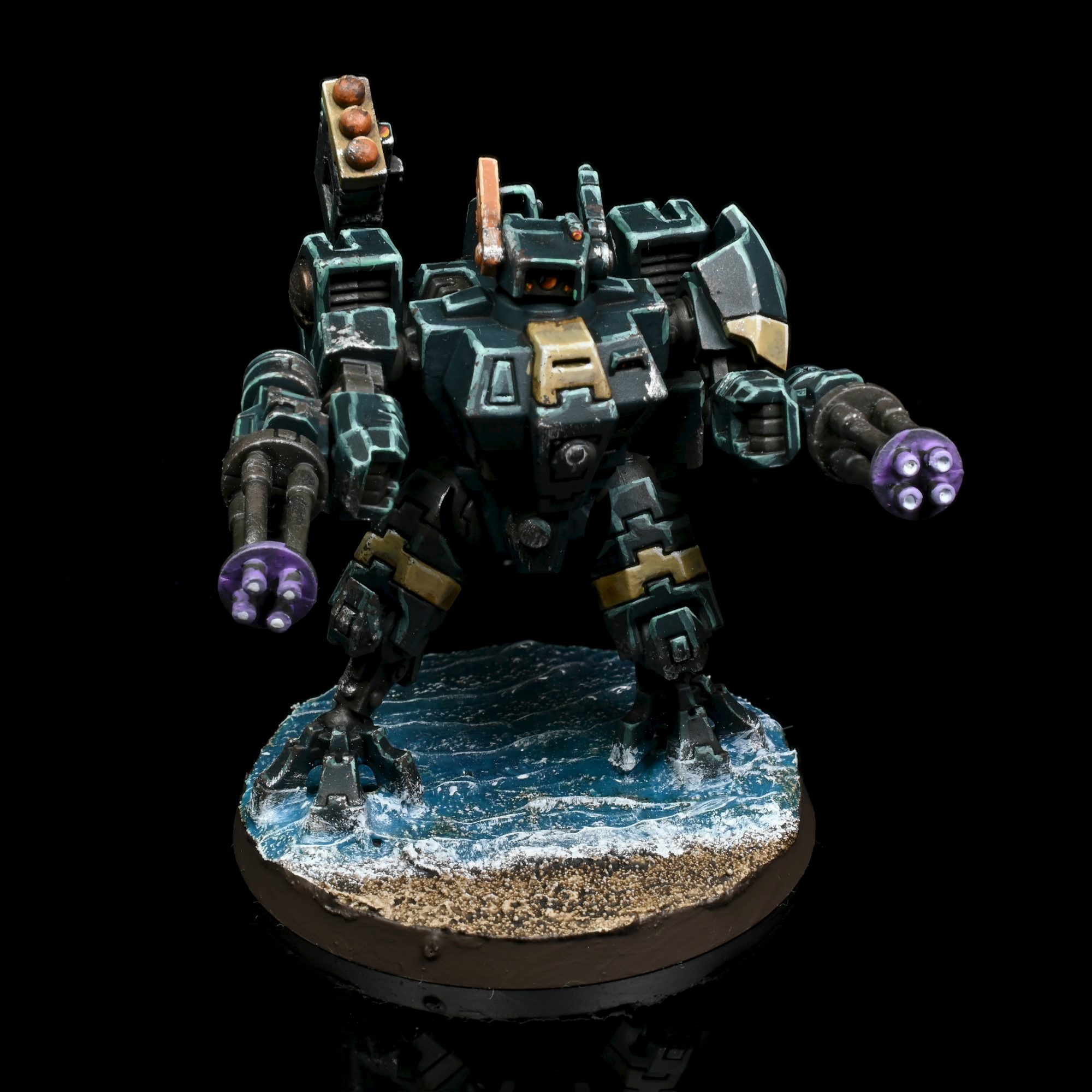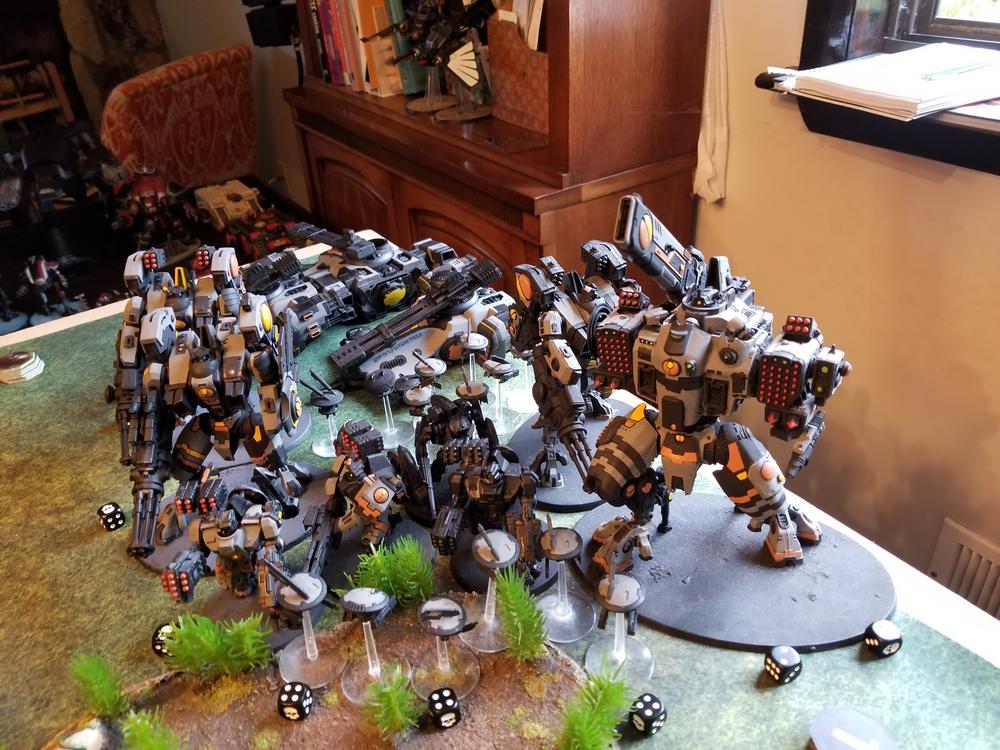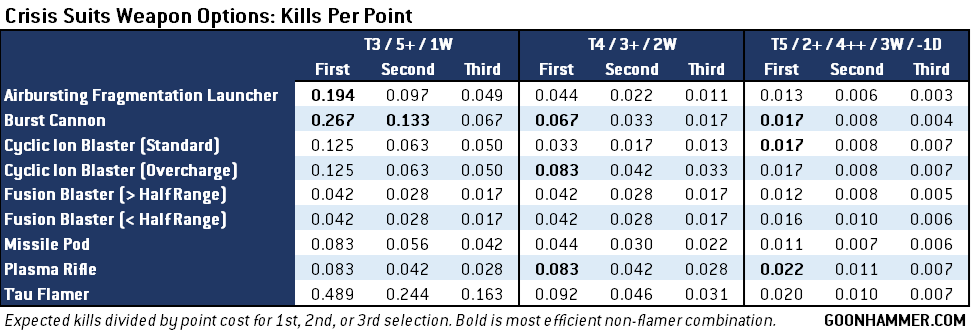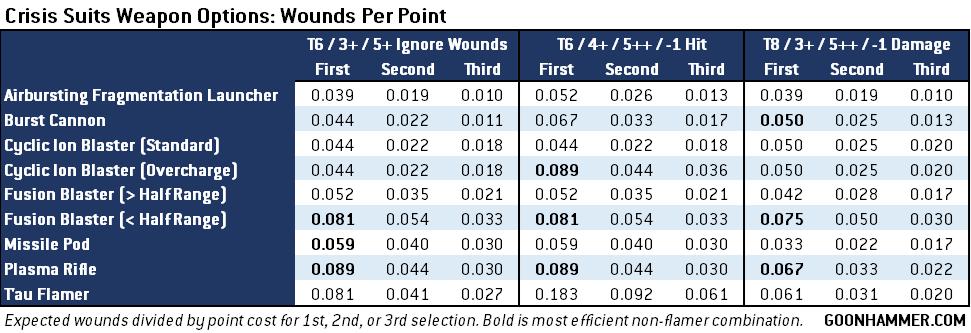This week’s Hammer of Math takes a look at the myriad of options that are available for T’au Crisis Battlesuits, and how the escalating cost for repeating the same weapon could change how players configure these units.
Crisis Battlesuits, along with giant murder cannons and loathing melee with a passion, are the a key defining element of the T’au faction. In a universe full of gritty, barely understood technology, the shining aesthetic of the T’au are exemplified by these highly customizable, hard-hitting battlesuits which make the pilot tougher than a Space Marine and more lethal than a dreadnought. The latest codex has done quite a bit to make the T’au more competitive, and a major part of that is boosting up the viability of the Crisis Suit.

In game terms the Crisis Suit is a T5, 4 wound INFANTRY unit with a 3+ save. With a 10″ Move characteristic and the FLY keyword they are very maneuverable, and each unit can field up to three ranged weapons. What’s changed in the latest book is that players now have to pay a premium for fielding multiple attachments of the same weapon, which encourages diversity in the loadout. Every Crisis Battlesuit can pick from among these weapons, and the points in parenthesis are the cost for each weapon:
- Airbursting fragmentation launcher (5/10/20): An Assault D6, S4, AP -1, D1 weapon with the Blast keyword that does not require line of sight.
- Burst cannon (5/10/20): An Assault 6, S5, AP 0, D1 weapon clearly meant for anti-personnel work.
- Cyclic ion blaster (10/20/25): This Assault 3 weapon features two profiles; a S7, AP -2, D1 profile or a S8, AP -2, D2 profile which wounds (but doesn’t kill, take that Hellblasters) on an unmodified hit roll of 1.
- Fusion blaster (10/15/25): Your standard melta profile at Assault 1 and hitting on S8, AP -4, and dealing 6 damage with a +2 damage boost at below half range.
- Missile pod (10/15/20): Getting two shots at S7, AP -2, and 2D makes this a natural complement to the cyclic ion blaster.
- Plasma Rifle (5/10/15): Fires a single shot at S8, AP -4, and D3 but doesn’t get hot.
- T’au flamer (5/10/15): Anything within range receives D6+2 hits at S4, AP 0, and D1.
With a BS of 4+ their range attacks aren’t the most impressive, but a hit bonus from a markerlight, the Kauyon tactical philosophy, and certain Sept Tenets are certainly available to make things a bit easier.
The Method
For the purpose of this analysis, the plan is to look at the expected kills or damage for each weapon against five different profiles. T indicates toughness, a number with a single plus sign is a regular armor save, a number followed by a pair of plus signs is an invulnerable save, and W is the number of wounds the target has.
- Expected kills against T3/5+/1W representing a horde threat.
- Expected kills against T4/3+/2W to cover Primaris.
- Expected kills against T5/2+/4++/3W with -1 damage reduction to represent a hard to dislodge threat like Blightlord Terminators.
- Expected damage against a T6/3+ target that ignores wounds on a 5+, such as a Drukhari Talos.
- Expected damage against a T6/4+/5++ target with -1 to hit to represent a Drukhari Raider using the Lightning Fast Reactions Stratagem.
- Expected damage against a T8/3+/5++ profile with -1 damage reduction, representing a typical Tyranid monster in a Crusher Stampede.
For each profile we will take the expected value and divide it by the point cost for each stage of weapon. The end result will be a damage or kill per point metric that we can use to compare between the different weapons. The higher the value, the better the gun performs against a particular target for the points cost.

The Results
The charts below show the killer or wounds per points for the different target sets. The first chart is kills per point against a variety of low-wound targets, while the second is wounds per point against high-wound targets. The values that are bolded represent the most efficient combination for each threat, with the caveat that the flamer option was not chosen due to its short range. In many cases the combination of low cost and guaranteed hits makes the flamer a very appealing selection, but this does not take into account the cost of the Crisis Suit model itself or the risks associated with getting within 12″ of the enemy.

Against the low-wound targets the optimal loadout depended on the target. For a horde-style target a combination of two burst cannons and an airburst fragmentation launcher was ideal; although not included in this analysis the launcher is even more appealing when the target is large enough to set off the Blast trait (and the upside of not requiring line of sight may be very big, but as it’s something you pay for that doesn’t reflect in the statistical output, it may be under-valued here). Against more heavily armored targets the nominal combination was a burst cannon, cyclic ion blaster, and plasma rifle. The plasma rifle in particular performed very well thanks to its low cost and high damage.

Against the higher-wound targets the fusion blaster makes a consistent appearance along with the plasma rifle. Depending on the target the optimal remaining gun may be either the missile pod, the cyclic ion blaster, or the burst cannon. Note that the cheap flamer once again makes an appearance courtesy of automatically hitting the target and its very low points cost, but as before the range is a concern. That said, if you’re running Farsight Enclaves, you’ll likely be doing a lot of your work at the 12″ range, and so the flamer should receive more consideration.
Conclusions
Assuming the cost of getting a Crisis Suit is “sunk” (meaning that you have to pay for it regardless, so you can discount the points paid), there are a limited number of scenarios in which you would want to use two of the same weapon (let alone three). In general the plasma rifle and cyclic ion blaster proved to be very useful against a wide variety of targets, with the third slot occupied by either a fusion blaster or a burst cannon. The other interesting option is the flamer, which is pretty efficient for the points but has some serious limitations. With a few big guns around to deal with the very heavy stuff the combination of burst cannon, cyclic ion blaster, and plasma rifle is extremely versatile.
Thanks for reading! If you have any questions or comments feel free to drop us a note in the Comments below or email us at contact@goonhammer.com.


